![]()
![]()
![]()
Use LEFT and RIGHT arrow keys to navigate between flashcards;
Use UP and DOWN arrow keys to flip the card;
H to show hint;
A reads text to speech;
21 Cards in this Set
- Front
- Back
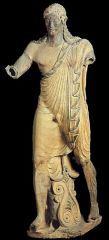
|
Apollo of Veii, Italy Etruscan 520-500 BC
• placed on top of Etruscan temple • made of terra cotta -- not very durable material |
|
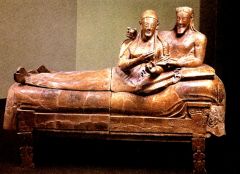
|
Sarcophagus from Cerveteri, Italy
Etruscan 520 BC • also terra cotta • man and wife together on banqueting couch • expresses relative equality of women in Etruscan society • each figure holding an egg originally • egg = symbol of rebirth, expresses Etruscan ideas of the afterlife |
|
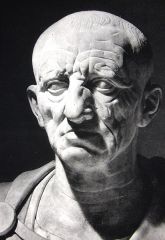
|
) Portrait of a Roman Patrician Republic 75-50 BC
• veristic portrait with wrinkles, etc. • expression is one of gravitas • part of tradition of venerating ancestors |
|
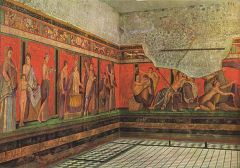
|
Villa of the Mysteries Republic 50 BC
• fresco in house just outside of Pompeii • depicts an initiation rite for a mystery cult (probably Dionysus) • painting creates illusion of a shallow stage • like Hellenistic art – dynamic, expressive, dramatic |
|
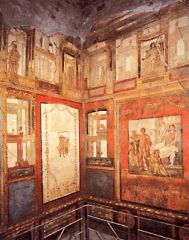
|
Ixion Room Pompeii, Italy Republic 70-79 AD
• from the House of the Vettii, a typical Roman house in Pompeii • house would be laid out around one or two open courts • an atrium, inside the entrance, was open to the sky, had a shallow pool to capture rainwater • the Ixion room is an inner room, probably a dining salon, with the walls painted to look as if one were witnessing a scene or looking out • one part uses architectural elements to create intuitive perspective • another features the god Ixion, punished by Zeus for attempting to seduce Hera • bottom register, called the dado, has a faux finish – painted to look like marble |
|
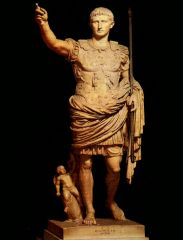
|
Statue of Augustus Primaporta, Italy Empire 20 BC
• combines Greek tradition of idealized physique with Roman veristic portraiture • inclusion of Cupid reminds us Augustus supposedly descended from Venus • propaganda piece: divinity, role as commander in chief, hand upraised in leadership |
|
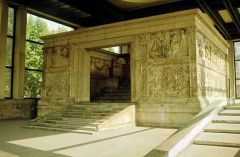
|
Ara Pacis Rome, Italy Empire 13-9 BC
• erected by senate to honor Augustus • one side wall is realistic portrait of procession of Augustus’ family -- like Parthenon frieze except not generalized & includes women and children • other side shows allegory of peace |
|
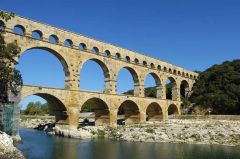
|
Pont du Gard Nimes, France Empire 16 BC
• Largest surviving Roman aqueduct & bridge – note dual function • could supply 100 gallons of water a day per person • brilliant engineering feat brings water from 30 miles away down gradual slope • only arch and concrete technology made it possible • also aesthetically pleasing – the rhythm of the arches |
|

|
Colosseum Rome, Italy Empire 70-80 AD
• built by Vespasian, who pulled down Nero’s golden house to make way for it • again, a marvel of engineering and planning – 60,000 people could exit in 15 minutes • arch technology makes it possible to build up to height of 16-story building • three different kinds of decorative arches • would have been faced in travertine stone and marble • free to enter – part of program to keep the people happy (like Baths of Caracalla later) |
|
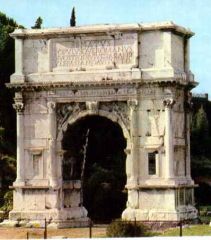
|
Arch of Titus/Spoils of Jerusalem Empire 81 AD
• first triumphal arch • no pragmatic purpose – to celebrate Roman victory and greatness of emperor • relief shows Roman troops looting the Temple in Jerusalem • propaganda related to the folly of opposing the Roman empire |
|
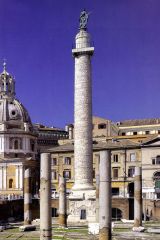
|
Column of Trajan Rome, Italy Empire 112 AD
• continuous spiral frieze for 636 feet • depicts conquest of the Dacians by Emperor Trajan • as much about the pragmatic aspects of warfare as battles • in center of Trajan’s forum, huge building project with Appolodorus as architect |
|
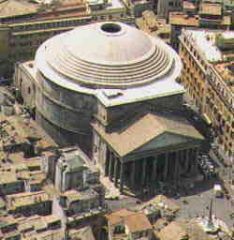
|
Pantheon Rome, Italy Empire 118-125 AD
• largest dome for 18 centuries • perfect sphere would fit inside – 142 feet in diameter, 142 from floor to oculus • describes space rather than mass • left intact by Visigoths who were awed by it • consecrated as a Christian church – other reason it’s still intact |
|
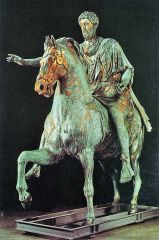
|
Equestrian statue of Marcus Aurelius Rome, Italy Empire 175 AD
• only extant bronze equestrian statue • popes didn’t melt it down because they thought it was first Christian emp. Constantine • propaganda: horse is small so that emperor looks more imposing • change of fashion -- long hair and beard, reflecting his status as a philosopher |
|
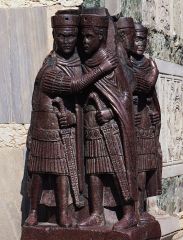
|
The Tetrarchs Venice, Italy Empire 305 AD
• Roman empire divided into east and west, with Augusti and Caesars by Diocletian • Statue of very hard stone – Egyptian porphyry • Expresses the unease and insecurity of the empire under attack from Barbarians • Not realistic, very abstract |
|
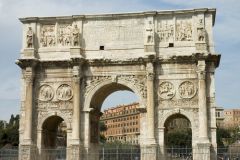
|
Arch of Constantine Rome, Italy Empire 312-315 AD
• begun just after Constantine’s victory over Maxentius • includes sycophantic praise from the senate • includes roundels removed from earlier monuments to Trajan, Hadrian & Marcus |
|
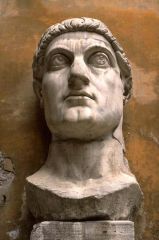
|
Portrait of Constantine Rome, Italy Empire 315-330 AD
• an expression of power and authority • not a veristic portrait – idealized, youthful • monumental size (8 1/2 feet tall) |
|
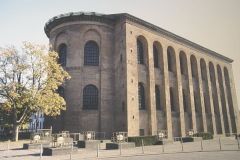
|
Aula Palatina Trier, Germany Empire early 4th century
• originally a Roman basilica built while Constantine was “Caesar” of the north • long nave capped by apse at the end, which would have housed statue of emperor • flat wooden ceiling, brick exterior, paned glass windows • model for future Christian basilicas |
|
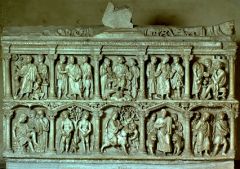
|
Sarcophagus of Junius Bassus Empire 359 AD
• made for prefect of Rome who converted to Christianity just before he died • Christians believed the entire body had to be buried; rejected cremation • Biblical stories, including entry into Jerusalem, depicted in niches on surface • Pagan elements persist: god holding up sky under Christ’s feet, where he is enthroned as if he were a Roman emperor • one of the earliest examples of typology, a one-to-one correspondence between an Old Testament occurrence, such as the Fall, and a New Testament occurrence, such as the Crucifixion |
|
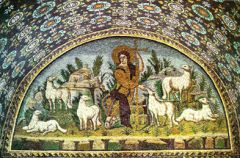
|
Christ as the Good Shepherd Ravenna, Italy post Empire 425 AD
• transitional art work • shows Christ in gold and purple robes of an emperor with halo • but Christ also still looks like Apollo – clean shaven with curly hair • still using Roman techniques of modeling and perspective • using mosaic, to be durable and legible • good shepherd important Christian symbol – refers to Christ telling apostles that the good |
|
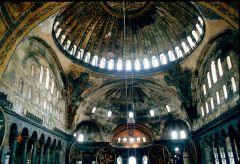
|
Hagia Sophia Anthemius & Isidorus Istanbul Byzantine 532-537
• built to embody the principle that God is light • dome resting one pendentives, with half domes all around • remarkably stable and long lasting |
|
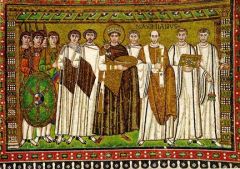
|
Mosaics: Emperor Justinian and Empress Theodora Ravenna Byzantine 547
• expresses the combined secular and spiritual authority of the Byzantine emperor • shows the two monarchs participating in the Eucharist -- she with chalice, he with paten • shows new expression of relative status • Byzantine technique – gold background, flattened picture plane, unrealistic figures |

